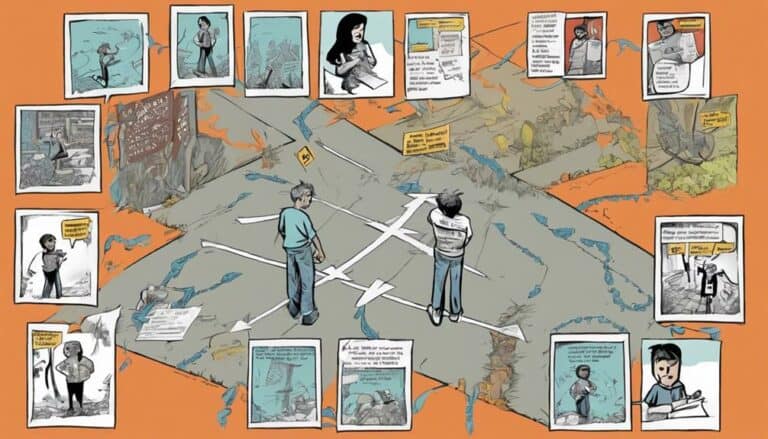When facing decisions, you must navigate through identifying the problem, evaluating outcomes, embracing flexibility, and fostering diverse thinking. Each step plays a critical role in the decision-making process, but have you ever considered how biases, time constraints, and emotional intelligence impact your choices?
Understanding these nuances can greatly enhance your strategic decision-making abilities. So, what key strategies can you implement to improve your decision-making skills and drive successful outcomes?
Key Takeaways
- Define the problem clearly and align decisions with goals.
- Gather reliable information from diverse sources for informed choices.
- Evaluate alternatives based on advantages, feasibility, and impact.
- Make decisions objectively, considering pros and cons of each option.
Identifying the Decision
When identifying a decision, clearly defining the problem or question at hand is vital for establishing a specific goal. To make a decision effectively, it's important to guarantee that the problem is articulated in a precise and measurable manner. By doing so, you set the stage for a focused approach towards finding the best solution. Aligning the decision with your overarching goals and values provides a framework for evaluating potential outcomes.
The decision-making process hinges on your ability to grasp the context, scope, and urgency of the situation. Understanding these factors enhances clarity and enables you to navigate towards a resolution more effectively. By concentrating on relevant information and pertinent details, you can streamline the decision-making process and avoid being swayed by extraneous factors.
Basically, the ability to clearly identify a decision lays the groundwork for a successful outcome. It sets the tone for gathering the necessary information and starting on a structured approach towards making a well-informed decision that aligns with your objectives.
Gathering Relevant Information
To advance your decision-making process effectively, the next essential step involves gathering relevant information through researching facts, data, and evidence pertinent to the decision at hand.
When gathering information, it's important to assess the quality, reliability, and validity of the data you collect. Seek out diverse and credible sources to guarantee a well-rounded understanding of the situation. Avoid relying on assumptions, opinions, or emotions to maintain objectivity throughout the process.
Understanding the situation thoroughly, exploring various alternatives, and evaluating the potential consequences of each option are key aspects of gathering relevant information.
Evaluating Alternative Solutions
In evaluating alternative solutions, meticulously analyzing the advantages and disadvantages of each option is imperative to determine the most suitable course of action. To make informed decisions, it is essential to identify possible solutions and evaluate their pros and cons thoroughly. Consider factors such as feasibility, costs, benefits, and risks associated with each alternative. Assessing the impact on goals, resources, and stakeholders is crucial. By understanding the potential outcomes and consequences of each solution, you can make a well-informed choice. Additionally, comparing alternative solutions based on their alignment with objectives and criteria will aid in selecting the best decision.
| Pros | Cons | Feasibility |
|---|---|---|
| Cost-effective | Time-consuming | High |
| High success rate | Resource-intensive | Medium |
| Meets objectives | Limited scalability | Low |
| Positive stakeholder impact | High initial investment | High |
Making the Decision
For effective decision-making, carefully assess all available options to determine the most suitable solution that aligns with the situation's requirements. Making the decision involves identifying the most relevant choice from the list of evaluated alternatives. It's essential to weigh the pros and cons of each option, considering how well they address the problem or situation at hand.
The decision should be based on objective facts gathered during the information collection phase. When making decisions, make sure that the chosen solution aligns with the needs of the specific circumstance. Clear articulation of the decision is important to avoid ambiguity and make sure all stakeholders understand the rationale behind the choice.
Reviewing and Adjusting
Tracking the performance and outcomes of your chosen solution through reviewing and adjusting is crucial to guaranteeing alignment with your goals and objectives. Monitoring the progress allows you to collect feedback and data to evaluate the effectiveness of your decision. By reflecting on the decision-making process, you can pinpoint areas for improvement and make necessary adjustments to enhance performance. This systematic approach guarantees that your decisions remain on track and meet the desired outcomes.
| Reviewing and Adjusting Components | Description |
|---|---|
| Monitoring | Track performance and outcomes |
| Feedback | Collect feedback for assessment |
| Adjustments | Make necessary changes |
| Reflection | Identify areas for improvement |
| Performance | Guarantee decisions meet objectives |
Conclusion
As you navigate the labyrinth of decision-making, remember to wield the torch of clarity, the compass of information, and the map of alternatives.
Just as a skilled navigator adjusts their course in turbulent waters, so too must you review and adjust your decisions to stay on the path to success.
Embrace the journey of decision-making, for in its twists and turns lies the key to opening a brighter future.

